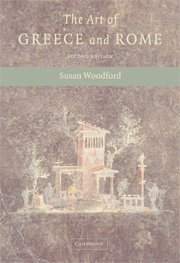Book contents
- Frontmatter
- Contents
- List of Illustrations
- Acknowledgements
- Maps
- Introduction
- PART I THE ARCHAIC AND CLASSICAL PERIODS: PROGRESS AND PROBLEMS
- 1 Free-Standing Statues
- 2 Greek Temples and Their Decoration
- 3 Painting and Painted Pottery
- PART II THE FOURTH CENTURY BC AND THE HELLENISTIC PERIOD: INNOVATION AND RENOVATION
- PART III THE ROMAN WORLD: ADOPTION AND TRANSFORMATION OF THE GREEK LEGACY
- Epilogue
- Appendix: How We Know What We Think We Know
- Glossary
- Further reading
- Index
3 - Painting and Painted Pottery
- Frontmatter
- Contents
- List of Illustrations
- Acknowledgements
- Maps
- Introduction
- PART I THE ARCHAIC AND CLASSICAL PERIODS: PROGRESS AND PROBLEMS
- 1 Free-Standing Statues
- 2 Greek Temples and Their Decoration
- 3 Painting and Painted Pottery
- PART II THE FOURTH CENTURY BC AND THE HELLENISTIC PERIOD: INNOVATION AND RENOVATION
- PART III THE ROMAN WORLD: ADOPTION AND TRANSFORMATION OF THE GREEK LEGACY
- Epilogue
- Appendix: How We Know What We Think We Know
- Glossary
- Further reading
- Index
Summary
PAINTING ON WALLS AND PANELS
The Greeks, like us, thought of painting primarily in terms of paintings on walls and panels. Large paintings on flat surfaces were often used to decorate architecture; metopes, for instance, would sometimes be painted rather than carved in relief. Figure 57 shows a 7th-century bc example. The metope is about a metre square and depicts the hero Perseus, who, having beheaded the fierce Gorgon and put her terrifying head in a bag (the eyes can be seen peering out), runs off to the right. The pin-wheel form of the figure in flight is well conceived to fill the whole surface of the metope in a decorative and lively way. The metope is made of terracotta and painted in shades of black, purplish-red and orange, colours that were suitable for firing. There is no effort to show the figure realistically in space; this is just a fine pattern, recognisable as a running man, arranged to make a handsome decoration.
This is practically the only well-preserved example we have of large-scale painting from this period.
The Greeks also painted on wooden panels. In Figure 58, several women are shown chatting, their delicate profiles outlined in red. Reds and blues are freely used for their clothing. This is an exquisite piece of drawing. It is still very flat, but the overlapping of one figure on top of another suggests the existence of the figures in space. The panel was painted in the later 6th century bc.
- Type
- Chapter
- Information
- The Art of Greece and Rome , pp. 38 - 58Publisher: Cambridge University PressPrint publication year: 2004



